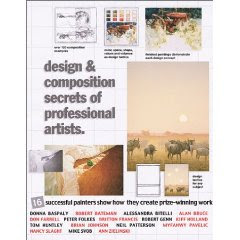Then comes the time when you are in your own studio with a blank canvas , and you realize that it's not about the techniques you worked so hard to learn, but that the work you create should be about something. Art is a form of communication and all the decisions from topic onward are yours to make. In my own situation, I had taken dozens of classes and workshops, read numerous art books, seen thousands of art works in my travels, been to local art galleries and had friends who were successful artists. I wanted to be an artist who created thoughtful work. About what? Panic!
It's a scary time, a time when you realize that if you are going to be successful, you have to bring something unique to the work you do. If you don't have something that is unique to add, why bother? Around the time of this epiphany I was reading a book called Design and Composition Secrets of Professional Artists.
 This was an important book in my career that taught me that there are many roads to follow, and that they all begin with a personal view of the world. It was also at that time that I accepted that my past experiences in another profession were an advantage rather than something that was setting me back. I'm sure Donna Baspaly has no idea that several points on one of her composition checklists changed how I began to think about subject matter. Donna relies heavily on a series of checklists to keep her in tune with her work through the whole process of creation.
This was an important book in my career that taught me that there are many roads to follow, and that they all begin with a personal view of the world. It was also at that time that I accepted that my past experiences in another profession were an advantage rather than something that was setting me back. I'm sure Donna Baspaly has no idea that several points on one of her composition checklists changed how I began to think about subject matter. Donna relies heavily on a series of checklists to keep her in tune with her work through the whole process of creation.While I've made some minor additions these are Donna's questions about subject:
- why are you attracted to the subject? why does it appeal to you?
- what emotion grabs you when you look at it? how can you express this emotion?
- what part of the subject should be emphasized to maximize that emotion/impression?
- what colours/key suits the mood you want to impart?
- what will identify this painting as yours (showing yourself in the painting) ?
Tom Huntley in this same book agrees that all starts with subject and advises "do not record what you see, interpret what you feel."
5 comments:
Excellent post, Margaret! I agree with the points you posted and have an almost identical approach. Personally, I thinks it's a good idea to articulate what it is you want to paint before you do it. This allows the artist to focus and select only the elements that support that concept. The articulation doesn't have to be a long explanation - it could be just a couple of words. Years ago I took a painting workshop from Christopher Schink and he gave some great advice. He said to think about what it is you want to paint and then ask yourself "Has this been painted before?" If the answer is "yes" then find a way to express it uniquely without imitation. That certainly requires an injection of individual perspective.
You have a great way of stating things and I appreciate this blog!
All excellent points-- I paint in a series-- 10-20 paintings-- and my subject matter or theme for each series is very important to me and well thought out-- and my elements ie. colors, textures stay constant for each series. I think the final goals for each artist is that they paint meaningful, personal unique and recognizable works.
Thank you wise women for your comments. I noticed you both paint in series, as I do. I think this is an excellent way to become fully entrenched in a theme and to examine it from different perspectives.
The times I am left floundering with a piece (not knowing what it needs or where to do next) are the result of just working and not having an intent. This usually happens to me when I am painting with a friend or taking a workshop.
EntzГјckend viagra generika viagra preisvergleich [url=http//t7-isis.org]generic cialis online pharmacy[/url]
急いで! [url=http://japanese-garden.org]バイアグラ 個人輸入[/url] バイアグラ 服用
Post a Comment